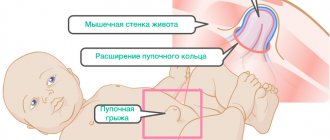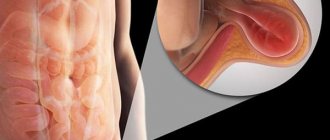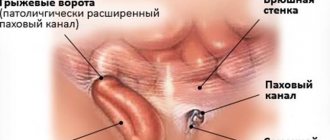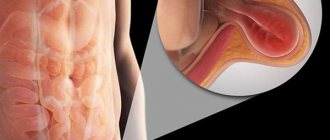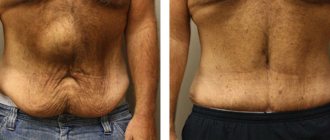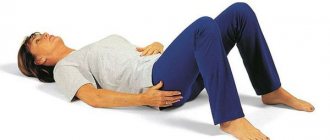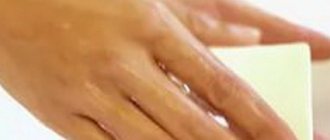Description of the disease
A hernia in a child’s navel is one of the most common surgical pathologies, which is more often observed in premature babies and underweight newborns, which is due to the immaturity of connective and muscle structures.
In itself, such a protrusion is completely harmless, although it frightens parents with its appearance. It does not cause pain, itching or other discomfort and in the vast majority of cases goes away on its own. The threat is posed by a condition called strangulation: it is compression of the hernial sac, which entails a disruption of the blood supply and the gradual death of surrounding tissues. Strangulation of an umbilical hernia in children is a direct indication for immediate surgical treatment.
Using an adhesive patch
This remedy can be used for newborns as soon as their umbilical wound has healed. The patch is glued so that a small fold is formed. The course of wearing the patch is 10 days. Typically, three courses are required with breaks in order to completely eliminate a hernia in an infant. The patch must be selected from a hypoallergenic material that allows air to pass through, so as not to irritate the baby’s sensitive skin. To ensure that the treatment of the disease is as effective as possible, it is recommended to combine the use of the patch with other methods. In this case, the result is more stable.
Classification
There are several classifications of the disease according to certain criteria. The main thing is to distinguish types based on origin. There are two types:
- congenital or embryonic defects that occur in a child even at the stage of intrauterine development, they are caused by disturbances in the formation of the abdominal wall;
- acquired or postnatal hernias that develop in infants during the first 1–4 months of life.
Additionally, direct and oblique hernias are distinguished depending on the direction of the protrusion, as well as reducible and irreducible.
Symptoms of an umbilical hernia in a child
First of all, the disease manifests itself externally in the form of a protrusion in the navel area, which is noticeable all the time or occurs when the baby coughs or cries. In a calm state, for example, when a child is sleeping, the hernia can almost completely “hide” in the abdominal cavity.
The size of the bulge varies from a few millimeters to 1–2 cm or more, and the larger the bulge, the more difficult it is to reduce under pressure. Additional signs of pathology may include:
- the appearance of brown spots in the navel area, which is caused by tissue scarring and the use of local antiseptics to treat the umbilical wound;
- an increase in the volume of protrusion when crying, the whims of the baby, during the period of ARVI, constipation, flatulence and colic;
- manifestation of a visible capillary network on a large hernia.
Children of preschool and school age may complain of discomfort and mild pain during physical activity, nausea, constipation and increased gas formation.
Hernia developed due to diastasis of the abdominal muscles
With a hernia of the linea alba, the rectus muscles diverge in the area of the aponeurosis along the midline. Intestinal loops, a small part of the stomach, omentum, and the left lobe of the liver can protrude through this hole. The formation can form above, below or near the navel.
Sometimes hernias due to diastasis are multiple. The defect is very rare, occurring in approximately 0.8% of cases. The cause of the pathology is the underdevelopment of the aponeurosis. Insufficiency of fibers in the linea alba can be caused by genetic predisposition, abdominal obesity, or trauma.
A defect is formed when there is a surge in pressure inside the abdominal cavity, for example, during strong screaming and crying in infancy, during physical stress, constipation, severe coughing, and impaired urination. The pathology is formed in several stages. At the stage of preperitoneal lipoma, preperitoneal tissue falls out through a defect in the fibers.
Next, a peritoneal pocket is formed, inside which there may be part of the intestine, omentum, or stomach wall. Upon final formation, the hernial sac is noticeable and can be easily palpated. Often the hernia does not develop and remains at the first stage, when the protrusion is hidden.
A hernia of the linea alba often does not cause pain and is discovered during a routine examination
The main sign of pathology is a painful protrusion along the white line. The pain becomes more intense after eating, exercising, sneezing, coughing, or straining. The pain can radiate to the hypochondrium, scapula, and lower back. Often the defect can cause nausea, belching, and heartburn.
A strangulated hernia occurs when the prolapsed organs are sharply compressed by the hernial orifice. In this case, the child develops acute abdominal pain, the intensity of which increases, nausea and vomiting, gases do not pass away, blood is visible in the stool, and the sac itself cannot be reduced. To determine the contents of the resulting peritoneal pocket, it is necessary to undergo radiography, gastroscopy, ultrasound, and MSCT of the abdominal cavity.
Treatment of the pathology is possible only through surgery. During the operation, a pocket of the peritoneum is cut, its contents are visually examined, part of the omentum is cut out, and diastasis (divergence) of the abdominal muscles is eliminated. Prevention of the development of a hernia is training the abdominal muscles, a balanced diet, normalizing stool, maintaining weight within the age norm, and preventing the child from lifting heavy objects.
Reasons for the development of the disease
Hernias form due to weak muscles in the anterior abdominal wall. The causes of a congenital hernia in a child can be:
- hereditary predisposition;
- intrauterine infection;
- congenital defects and developmental anomalies.
The causes of acquired umbilical hernia in children can be:
- gastrointestinal disorders (constipation, colic, flatulence);
- getting up and walking earlier;
- hacking cough;
- constant crying and screaming;
- prematurity;
- excess body weight;
- accumulation of fluid in the abdominal cavity;
- birth weight deficiency;
- rickets;
- heredity;
- malnutrition.
It has been proven that the pathology is more common in premature babies: every third child born prematurely experiences this disease.
Surgery without hospitalization...
Up to 80% of all operations for surgical diseases in children can be performed in a one-day hospital setting. The specialists of the CELT Children's One-Day Hospital came to this opinion a long time ago—one of the first in our country. The advantages of a one-day hospital are obvious: reducing the waiting time for surgery, eliminating the psycho-emotional trauma of the child from separation from parents and maintaining the usual biorhythm during postoperative rehabilitation, reducing treatment costs due to the elimination of costs for a long hospital stay and paying for additional staff, eliminating the risk of intra-hospital infections. This primarily applies to diseases such as hernia. In the postoperative period, children do not require medical care, observation, regimen or diet. Rehabilitation at home is much faster and easier. The use of medications at home is limited to a single dose of an analgesic tablet on the first day.
Treatment of umbilical hernia in childhood
In general, the tactics of treating the disease can be divided into two areas: conservative techniques and surgical intervention.
A conservative approach is rational if the hernia is small in size, does not cause inconvenience and is not fraught with danger. Basically, a wait-and-see tactic is used: in most cases, umbilical hernias in young children go away on their own as they grow older. Additionally, the doctor may prescribe wearing a special bandage that minimizes the risks of pinching and further growth of the protrusion, massage, application of a patch and other auxiliary measures.
If the hernia has not healed in a child under 5 years of age, there are signs of strangulation, acute intestinal obstruction, or the size of the formation is alarming, surgical treatment is performed. It consists of repositioning the prolapsed internal structures into the abdominal cavity and suturing the hernial orifice. This operation is called hernioplasty and is carried out mainly as planned.
Rehabilitation period
This operation belongs to the so-called outpatient surgery. After direct surgery, the child spends 6 to 12 hours in the hospital, after which he is sent home. Before discharge, it is imperative to consult with your doctor to receive recommendations for caring for your child. It is very important to clean the wound daily and keep it clean. After a week (or 10 days), you must come to the Center to remove the stitches and observe the surgeon. It is worth noting that the rehabilitation period is quite easy, since almost all children tolerate such surgical procedures well.
Prevention
To prevent the intrauterine development of hernias, it is necessary to take planning and management of pregnancy seriously, regularly visit a doctor and undergo prescribed examinations.
The following measures will help avoid the formation of pathology:
- natural feeding of the baby or careful selection of formula;
- putting babies on their tummy every day;
- During breastfeeding, the mother follows a balanced diet without foods that increase gas formation (legumes, cabbage, flour confectionery);
- daily bathing and gymnastics.
It is undesirable to let babies cry and scream for a long time and hysterically: increased pressure on the abdominal wall can provoke divergence of the hernial orifice and further growth of pathology.
What not to do if parents identify signs of an umbilical hernia in a child:
- heat, cool, rub and knead the protrusion area;
- apply any ointments, creams, folk remedies to the navel;
- independently give children any medications without a doctor’s prescription;
- forcefully reduce the protrusion if it does not respond to light pressure.
At the first signs of infringement, which include discoloration of the skin in the navel area, vomiting, bloating against the background of the child’s crying, it is necessary to call emergency assistance as quickly as possible or take the child to the hospital yourself.
If you suspect the presence of an umbilical hernia in your baby, make an appointment with the surgeons of the SM-Doctor clinic. Our specialists will conduct a thorough diagnosis and prescribe effective and most gentle treatment in accordance with the indications.
Physiotherapy
Often, umbilical hernia in newborn children can be well cured with the help of therapeutic exercises. In our clinic, experienced specialists will select the necessary set of exercises for the child.
You can also do some exercises on your own at home. For example:
- before feeding the baby, place the baby on his tummy (for a couple of minutes);
- turn the child onto the left and right side alternately for a couple of seconds;
- turn the child to face you and, holding his head, tilt him back slightly;
- when the baby is lying on his back, carefully lift him by the arms, while supporting his back (the head and legs hang freely);
- Also, while lying on your back, carefully turn the baby onto his tummy;
- Place the baby on a bulky ball and roll it around, holding it by the legs.
Children under 8 years old can visit a trainer and do exercises with him. Such services are also available in our clinic.

